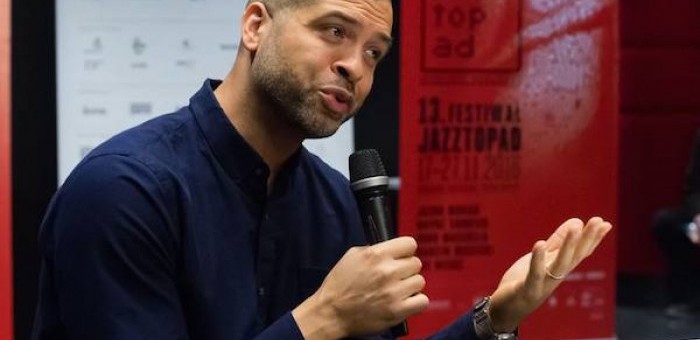Oct 28, 2025 10:47 AM
In Memoriam: Jack DeJohnette, 1942–2025
Jack DeJohnette, a bold and resourceful drummer and NEA Jazz Master who forged a unique vocabulary on the kit over his…

Jason Moran gives a lecture to Jazztopad attendees prior to his show at the festival on Nov. 18.
(Photo: Boguslaw Beszlej/Arch. NFM)The Jazztopad festival in Wroclaw, Poland, is deeply invested in the idea of commissioning new works. That message was amplified internationally when, in 2013, the festival commissioned Charles Lloyd’s multicultural concoction Wild Man Dance, which became a live recording representing the veteran saxophonist’s first album in a new record deal with Blue Note Records.
In a model of symbiotic energizing, Lloyd helped put Jazztopad on the map, while the festival’s intrepid artistic director Piotr Turkiewicz helped coax an ambitious, fresh creation out of Lloyd.
That commissioning factor, along with other innovative new ideas about what makes a successful festival, was alive and thriving in the 2016 model, with strong new “chamber-esque” works by Wayne Shorter and Jason Moran as pillars of the programming mix.
Wroclaw is the German city formerly known as Breslau, given to Poland in 1945 and undergoing a slow but sweeping renovation and transformation from a turbulent past. In its 13th annual edition this year, Jazztopad (a play on the Polish word for November, “Listopad”), the program also showcased this festival’s inquisitive ear for jazz from unexpected global locales (I was there for the first four days; the second part of the festival featured two nights of Japanese music, traditional and otherwise).
Among the memorable high points was the distinctive, fertile cross-rhythmic and cross-cultural energy of Colombian pianist Ricardo Gallo and his Cuarteto—blending familiar folkloric, jazz and “Latin Jazz” characteristics with refreshingly new musical chemistries—and the Hungarian Grencsó Open Collective.
Led by captivating, artfully impulsive and seasoned saxist/flutist István Grencsó, and following a mostly free musical mandate, the group’s set was something of a revelation, along with my first exposure to such superlative players as pianist Máté Pozsár and drummer Szilveszter Miklós.
From the all-important commission front, Shorter’s engaging new work The Unfolding, co-commissioned by Jazztopad, the Kennedy Center and Florida State University, takes as its conceptual foundation the birth of the universe, while evocatively illustrating the very idea of musical “unfolding” over its 20-plus minute duration.
The encounter with Polish musicians and Shorter’s longtime quartet in Wroclaw was several degrees bolder than the world premiere in Monterey in September, partly because of the superior acoustics in the magnificent new National Forum of Music concert hall, some refining and reworking of the score by the composer, and by virtue of this being the third performance, with a more comfortable relationship with its musical landscape.
Moran’s World Premiere of Wind shared with Shorter’s piece the format of a strong group at the center—Moran’s long-time trio Bandwagon, with drummer Nasheet Waits and bassist Tarus Mateen, joined by a special guest, the ever-tasty guitarist Marvin Sewell, and showcasing moments for fine Polish trumpeter Piotr Damasiewicz—with a chamber ensemble of strings and winds built around the core unit, which supplied improvisational input.
Moran is no stranger to unusual ideas and flexing creative muscle within the context of commissions. For a Monterey Jazz Festival commission in 2009, his intriguing piece Feedback took as a conceptual seed a short sample of Jimi Hendrix’s guitar feedback, recorded when the guitarist played that very stage during the legendary Monterey Pop Festival in 1967. It was a site-specific meditation on sound, place, memory and pop cultural mythology.
Having worked with artists of the performance and conceptual sort, beyond the realm of music for music’s sake, Moran is also open to revisiting and upending time-honored conventions. In this case, the subversive touch was to stage the musicians inside three large tents with translucent sides, which never opened to reveal the musicians.
Thus, the audience was kept half in the dark, half in the light, viewing the performers only as ghostly or dream-like characters, working against the tradition of bathing performers in spotlights. The staging also had a democratizing effect, reducing the traditional notion of the soloist’s heroic hierarchy in a jazz setting.
Wind, which quickly moved into its second performance, at the London Jazz Festival, is an impressive piece of work, in the conceptual fiber, structural arc and in the heat of the live moment. Structurally, it plays out like a modular mosaic—call it a windswept mosaic—which takes advantage of the textures within the ensemble, including the bass trombone meting out the propulsive bottom in a New Orleans second-line groove section deep into the piece.
Moran steered the group through a varied musical terrain, from darkly luminous chordal washes to taut, serpentine unison lines, in and out of lyricism and gentle dissonance, and a pleasingly anarchic free section. A mellow, relaxed three-bar motif in 3/4 guided us away, a gentle breeze of a final gesture.
After the maiden voyage and a standing ovation, Moran addressed the crowd, accentuating the collaborative nature of his grand venture. Beyond the musical fabric, he asserted that it is “a tribute to a market that is about sharing culture with one another. This piece and this music and this stage and these amazing curtains back here, is a real effort in community engagement ...”
Wind, in short, was a triumph, and an insight into another facet of Moran’s expanding musical vision. DB

Jack DeJohnette boasted a musical resume that was as long as it was fearsome.
Oct 28, 2025 10:47 AM
Jack DeJohnette, a bold and resourceful drummer and NEA Jazz Master who forged a unique vocabulary on the kit over his…

D’Angelo achieved commercial and critical success experimenting with a fusion of jazz, funk, soul, R&B and hip-hop.
Oct 14, 2025 1:47 PM
D’Angelo, a Grammy-winning R&B and neo-soul singer, guitarist and pianist who exerted a profound influence on 21st…

To see the complete list of nominations for the 2026 Grammy Awards, go to grammy.com.
Nov 11, 2025 12:35 PM
The nominations for the 2026 Grammy Awards are in, with plenty to smile about for the worlds of jazz, blues and beyond.…

Jim McNeely’s singular body of work had a profound and lasting influence on many of today’s top jazz composers in the U.S. and in Europe.
Oct 7, 2025 3:40 PM
Pianist Jim McNeely, one of the most distinguished large ensemble jazz composers of his generation, died Sept. 26 at…

Drummond was cherished by generations of mainstream jazz listeners and bandleaders for his authoritative tonal presence, a defining quality of his style most apparent when he played his instrument unamplified.
Nov 4, 2025 11:39 AM
Ray Drummond, a first-call bassist who appeared on hundreds of albums as a sideman for some of the top names in jazz…






